Explore Bologna, Italy's lively university town with historic charm, renowned cuisine, and vibrant culture in its sprawling Centro Storico.
Read more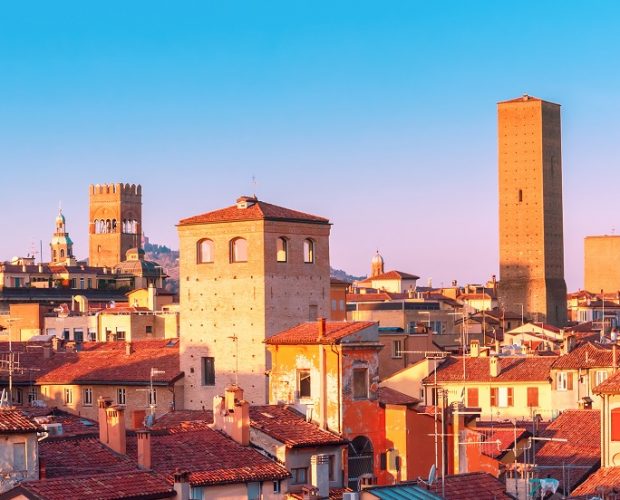
EXPLORE ALL OUR EMILIA-ROMAGNA WINE REGIONS GUIDE
Last updated: May 23, 2024
Despite being formidable winemakers, the Italians like to complicate things: Italy boasts over 350 DOC, 40 DOCG, and over 120 IGT designations that cover the length and breadth of the peninsula. Moreover, they incorporate various terroirs, mesoclimates, and subregions capable of bamboozling even the most committed oenophiles. Yet, on occasion, the authorities do get it right – they introduced the catch-all appellation Romagna DOC in 2011 to replace five distinct classifications, including the Cagnina di Romagna, Sangiovese di Romagna, and Trebbiano di Romagna DOCs. It makes it far easier to get to grips with the myriad of wine styles produced in the eastern half of Emilia-Romagna, where Sangiovese, Trebbiano, and Albana (covered in a separate DOCG) have been grown for over two millennia.
However, the region’s output is not all the same. While some wines may not capture your interest, you can find hidden gems, including some of Italy’s most exceptional Sangiovese wines, in the historic vineyards and secluded hills of Emilia-Romagna. If you’re in search of a high-quality alternative to Chianti Classico, Friuli Sauvignon Blanc, or Prosecco, Romagna DOC could be the perfect answer.
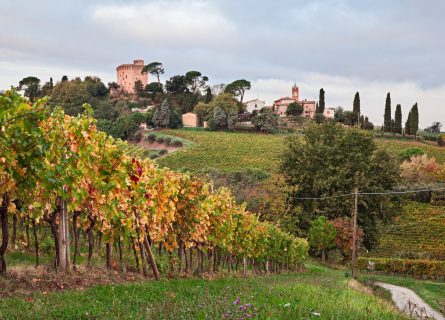
Romagna DOC is not just a geographical designation but a significant part of the viticultural landscape in northeastern Italy. Encompassing just over 3,400 hectares of vines, it is one of the largest designations in Emilia-Romagna, located to the south of Bologna and Ravenna on the Adriatic coast. Historically, people widely associated the zone with oceans of uninspiring varietal Trebbiano wine: neutral dry whites that were acceptable as an aperitif. Yet things are vastly different today, particularly as the Convito di Romagna ( Romagna’s Consorzio or regulatory council).
Yet things are vastly different today, particularly as the Convito di Romagna (Romagna’s Consorzio or regulatory council) continues to encourage higher standards among its growing membership, including promoting single-vineyard expressions and small-batch wines.
Climatic Challenges in Romagna
However, the climate in Romagna has its challenges. The region is known for its distinct sub-tropical weather patterns – a deluge of rainfall one minute and hot, humid days the next! Indeed, rainfall is a year-round phenomenon in this part of Emilia-Romagna, while violent thunderstorms can wreak havoc in the humid spring and summer months; coulure (a lack of fruit set) is a serious viticultural hazard that can reduce crop sizes by more than half in weak vintages.
Moreover, powdery and downy mildew can rear their ugly heads during June, July, and August, when warm, muggy conditions send fungal spores into overdrive. As a result, it is difficult to avoid a reliance on copper sprays in the region. However, quality-conscious growers try to keep the amount of synthetic pesticides – and herbicides – to an absolute minimum.
More positively, the Adriatic supplies cooling breezes in the summer, a key factor in maintaining acidity and freshness in the wines. Many of the best climats (vineyard sites) are found in the rolling hills southeast of Bologna, where elevation and aspect are most advantageous. These higher-altitude sites, increasingly in demand, also benefit from good drainage – another key element in a region that suffers from excess rain.
The local soils, meanwhile, can vary dramatically. Alluvial matter is abundant in some parts of the appellation, in addition to deep bands of clay and sand. Red grapes, particularly Sangiovese, tend to give the best results on Romagna’s calcareous terroirs, where water retention and drainage are in optimum balance.
Evolution of Grape Varieties and Recognition of Romagna Albana DOCG
Today, winegrowers plant much of the acreage with Sangiovese, Trebbiano, and Albana, marketing the latter under the Romagna Albana DOCG banner with great pride. In 1986, Albana di Romagna became the first white wine appellation to be promoted to DOCG status, made in both dry and sweet styles. In addition, growers cultivate a broad palate of esoteric and ‘minor’ grape varieties in the zone, even if their numbers are dwarfed by the big three. They include Centesimino, Refosco, and Terrano (red), the white grapes Garganega, Grechetto Gentile, and Bombino Bianco, known locally as Pagadebit.
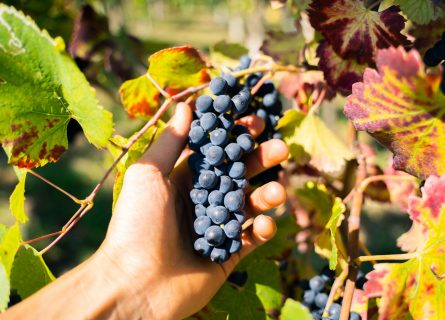
With five appellations rolled into one, Romagna DOC promises various styles and price points, appealing to novices and wine geeks alike. Nevertheless, its trump card has long been Romagna Sangiovese, grown in these hills since Roman times. After a slow start, it is becoming a serious rival to the more established red wines of Chianti Classico and Brunello di Montalcino in central Italy.
Much will depend, however, on the provenance of the grapes – and the winemaking. Bulk production (think overcropped vines and industrial-sized volumes) yields thin and dilute Sangiovese that is as astringent as it is forgettable; far too much of the region’s output conforms to this stereotype, despite the increased levels of investment seen over the past 15 years. Yet premium Romagna Sangiovese is the real deal: gutsy and full-bodied reds with elegance and staying power.
Indeed, some of the Sangiovese clones chosen by Tuscany’s leading winemakers are sourced in Emilia-Romagna. And, much like their neighbors, local producers treat their top labels with great care and consideration. Only hand-harvested fruit will be used, carefully vinified in stainless steel or concrete at controlled temperatures; this yields fruitier and better-balanced wines.
Maturation Techniques and the Mediocrity of Trebbiano
Meanwhile, a moderate to long extraction (and maturation in oak) obtains just enough tannin and ‘stuffing’ to allow the wines to improve in bottle after release, gaining velvety complexity and considerable depth. However, a great deal of Romagna Trebbiano is not worthy of a lengthy overview; the critical mass of wines are bland and very straightforward quaffable fodder. They are pleasant enough to drink alongside seafood and pasta dishes at best. Just don’t expect them to set the world on fire!
Yet, it’s a different story with Romagna Cagnin. The grape is a synonym of the Refosco variety, the key red style of Friuli-Venezia that also thrives in the warmer climate of Emilia-Romagna to the south. Here, it yields ripe and succulent reds, brimming with red fruit on the nose and a floral, juicy palate. Most winemakers ferment their Romagna Cagnin in stainless steel at low temperatures, eschewing oak aging for upfront, crystalline fruit. It remains one of the area’s best value buys, although relatively little is sent abroad.
Pagadebit, or Bombino Bianco, is another local gem. Although it can deliver inflated yields, older vines produce very fine and floral whites that are sometimes made into a frizzante (lightly sparkling) style or even traditional method fizz. It vies with Romagna Albana DOCG for the title of Emilia-Romagna’s greatest white, albeit the former is made in far greater quantities.
The area under vine is located southeast of Bologna, where vines carpet the gentle slopes of the Imola hills as they move eastwards towards the Adriatic. Planted on limestone and chalk soils, the vines also benefit from cooling maritime breezes and diurnal temperature variation in this undulating landscape – the ideal place to fashion balanced, fresh, dry whites.
Yet, like so many Italian traditions, the practice of making sweet wines refuses to die out despite falling demand. Zerbina makes the flagship style, renowned for its passito dessert wines that rely on grapes desiccated on the vine or dried out in indoor/outdoor wooden lofts. But, the skin-fermented dry whites are proving to be a major hit among influential sommeliers as the category comes back into vogue.
Romagna DOC is a classic tale of Italian reinvention and rejuvenation. After languishing in the shadows for most of the 20th century, the authorities realized in 2011 that promoting five distinct appellations was probably more trouble than it was worth; consumer bafflement and confusion are not marketing aphrodisiacs! 13 years later, the prospects for this expansive region have never looked so bright. Buoyed by a unified focus and collective representation from a single consorzio, the vineyards of Romagna are starting to earn the recognition they deserve.
Of course, you still have to discriminate: the penchant for making bland whites and astringent reds has not yet faded in the hills of Emilia-Romagna. However, the volume of premium wine – terroir-driven and wonderfully appetizing – increases with every vintage. Some of the greatest success stories are the single-vineyard Sangiovese reds, particularly those cultivated at higher altitudes in the foothills of the Apennines.
By focusing on the twin virtues of site selection and ‘sensitive’ winemaking, producers have refined local expressions by emphasizing terroir. As a result, there has been a boom in excellent Sangiovese, a grape variety that can thrive on elegance and transparency as much as power. Meanwhile, similar trends are visible for local varietals such as Refosco and Centesimino.
Distinctive Character and Potential of Romagna’s White Wines
The best whites, too, can be very impressive: food-friendly and aromatic, with a freshness to balance their fruit. Albana, of course, has the highest profile, but Garganega and Chardonnay can also perform exceedingly well on the clay-limestone soils of the Romagna interior. The transformation of this ancient vineyard, once mired in apathy and mediocrity, is a joy to behold.
Discover Romagna Albana: A Diverse Wine Wonderland - From Sparkling Elegance to Rich Dessert Wines. Explore the Spectrum!
Find out moreChardonnay is a green-skinned grape varietal native to the Burgundy wine region in France and one of the most popular varieties worldwide.
Find out moreDiscover Garganega Wines: From Sweet Elegance to Vivacious Dry Delights | Explore the Complexity of This Exceptional Grape
Find out more
Discover Pinot Grigio's Transformation: From Ordinary to Exceptional in Italian White Wine. Explore the Revolution!
Find out moreExperience Trebbiano Toscano's Renaissance: Aromatic & Fresh Bianco Toscana IGT from Petrolo. The Future of Italian White Wine
Find out moreCentesimino, also known as Savignon Rosso, is a rare red wine grape from Emilia-Romagna, Italy, primarily found in Ravenna province. This variety was revived in the 1960s by Pietro Pianori, who propagated it from cuttings from a single vineyard. These vines, which survived phylloxera due to their isolation in a walled garden, remain one of the few ungrafted vinifera strains.
Unveil Refosco, Italy's secretive red wine family, with tannic, pungent wines. Explore its century-old mystery in our comprehensive guide.
Find out moreUnearthing Sangiovese: Italy's Ancient Grape with a Complex History. Explore its journey from Etruscans to modern-day excellence.
Find out more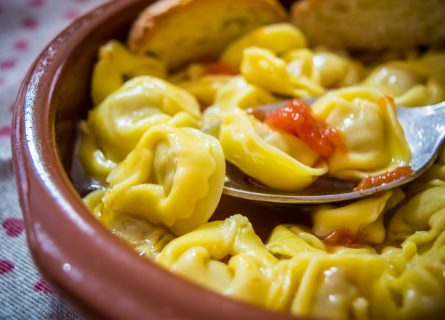
Emilia-Romagna’s cuisine is reputed to be among Italy’s finest. After all, this is where the famous Ragu alla Bolognese came into being, not to mention Parmigiano Reggiano, Lasagna Bolognese, Prosciutto di Parma, and Tortellini in brodo. The beautiful and unspoiled city of Bologna packs splendid places to eat, particularly in the streets, flanking the Piazza Maggiore and Piazza del Nettuno. Ask for a recommendation, or follow your nose!
A Gastronomic Guide to the Cuisine of Emilia Romagna: Read more

Explore Bologna, Italy's lively university town with historic charm, renowned cuisine, and vibrant culture in its sprawling Centro Storico.
Read more
Explore Modena's Culinary Delights and Automotive Heritage. Discover the World's Best Balsamic Vinegar and Ferrari's Birthplace.
Read more
Discover Parma, the culinary heart of Italy, where Prosciutto and Parmigiano Reggiano reign supreme. Explore its rich history and artistic heritage.
Read more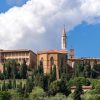
Discover Pienza's Renaissance Charm and Rich History in the Heart of Tuscany's Val d'Orcia. Explore Etruscan Roots, Renaissance Architecture, and Timeless Beauty.
Read moreIf you would like us to customize an exclusive luxury tour, contact us and let us know your travel plans. We offer luxury food and wine tours for private groups of a minimum two guests. In addition, all of our private, chauffeured tours are available year-round upon request.

